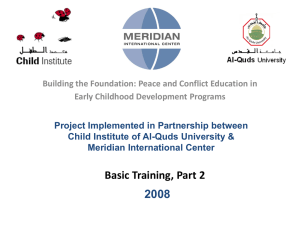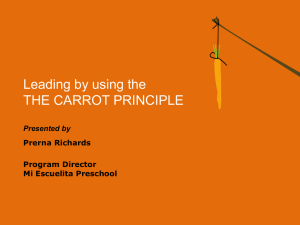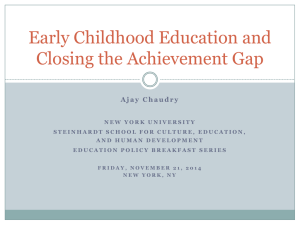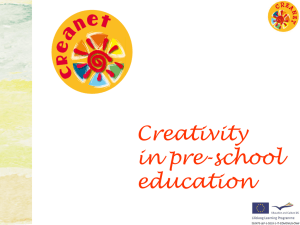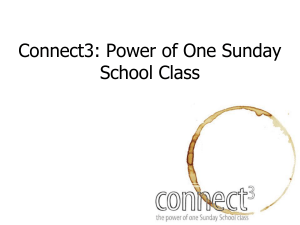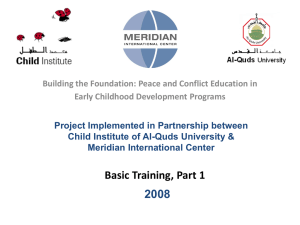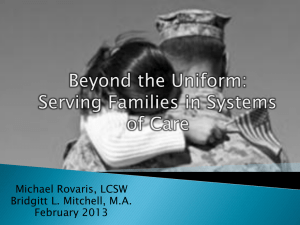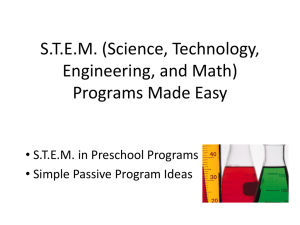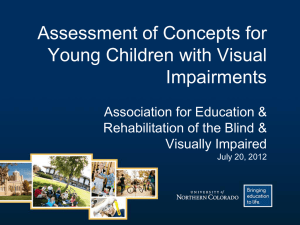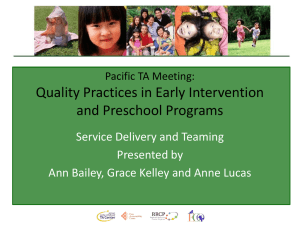Ramaviciene_presentation_2014
advertisement
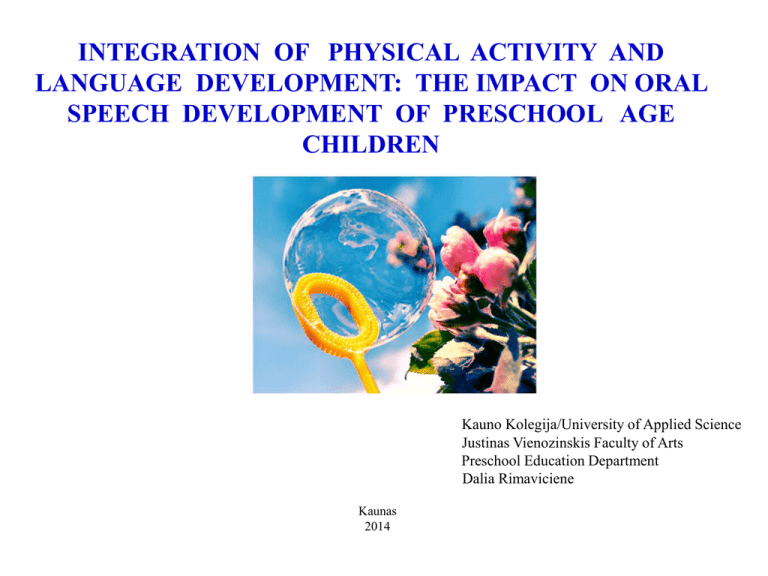
INTEGRATION OF PHYSICAL ACTIVITY AND LANGUAGE DEVELOPMENT: THE IMPACT ON ORAL SPEECH DEVELOPMENT OF PRESCHOOL AGE CHILDREN Kauno Kolegija/University of Applied Science Justinas Vienozinskis Faculty of Arts Preschool Education Department Dalia Rimaviciene Kaunas 2014 CONTENT • • • • Introduction Speech and language development in preschool age Preschool children’s language development possibilities in physical activity Conclusions AIM *to present speech and language development possibilities in preschool age children‘s physical activity. OBJECTIVES: *to highlight speech and language development moments in preschool age; *to emphasize the importance of the game to the child's language development; *to introduce some activities that help to develop speech and language skills in physical activity; *to practice some playful tasks that can secure correct language development. 1. INTRODUCTION • The first few years of a child’s life is a key to the development of speech, language and cognitive skills. • For this reason it is important to create activities and strategies to help to develop speech and language skills. • Through play and simple daily interactions and experiences we can help the child acquire a new language and skills. (http://www.icommunicatetherapy.com/child-speech-language/child-speech-language-development/activities-strategies-helpdevelop-speech-language-skills/). 1. • • • INTRODUCTION But speech and language skills do not just evolve on their own. They are a part of a bigger picture involving social interaction, play, observation, manipulating objects, listening and attending. All these things are working together and often, without one, it is difficult to develop another. 2. SPEECH AND LANGUAGE DEVELOPMENT IN PRESCHOOL AGE 2 years: • to show a picture when you ask. For example.; „Where is a cat?”; •to respond to one request; •to connected two words in a meaningful phrase; •to use a single group of consonants (for example.; n, t, d). 2. SPEECH AND LANGUAGE DEVELOPMENT IN PRESCHOOL AGE 3 years: •to perform a two-step application (for example.; pick up the ball from the ground and give it to me); •to understand the most common generalizing concepts (animals, clothes and so on.); •to use adjectives (high, low, small, big); •to identify basic color names; •to identify him well-known objects, without changing the names of onomatopoeic words (cow-moo); 2. SPEECH AND LANGUAGE DEVELOPMENT IN PRESCHOOL AGE 3 years: •to communicate at 3-4 word sentences using the prepositions; •to distort the vowels, simple articulation of consonants (m, p , b, n, t , d, k, g , v) ; •if complex of consonants (š , ž , c , c , l, r) child can’t say correctly – it’s a physiological norm in this age; •child’s language in this period must be understandable for all people. 2. SPEECH AND LANGUAGE DEVELOPMENT IN PRESCHOOL AGE 4 - 5 years: • • • • should use the extended sentences; to be able to formulate questions correctly; to pronounce correctly the sound z; in most cases in child’s speech appears the sounds (š, ž) . 2. SPEECH AND LANGUAGE DEVELOPMENT IN PRESCHOOL AGE 6 - 7 years: •the child has to pronounce all the sounds of a language correctly; •recognise the sound of the other alleged (sounds, syllables and words); •say, what's the first / last sound of the word; •be able to articulate many syllables, complex sound structure of words (kindergarten, helicopter); •to create the new words by analogy (a place where people eat - dining room); •to tell story coherently using a picture or a series of them, to describe the item and experienced feelings. 3. PRESCHOOL CHILDREN’S LANGUAGE DEVELOPMENT IN PHYSICAL ACTIVITY • It’s useful to exercise outdoors 3. PRESCHOOL CHILDREN’S LANGUAGE DEVELOPMENT IN PHYSICAL ACTIVITY *by using non-traditional teaching aims: COLOURED CARDS, MARBLES 3.PRESCHOOL CHILDREN’S LANGUAGE DEVELOPMENT IN PHYSICAL ACTIVITY *by using non-traditional teaching aims: COLOURED FLAGS, SHIPS 3.PRESCHOOL CHILDREN’S LANGUAGE DEVELOPMENT IN PHYSICAL ACTIVITY *by applying non-traditional teaching aims: Buttons, corks, paper flowers (footflat) 3.PRESCHOOL CHILDREN’S LANGUAGE DEVELOPMENT IN PHYSICAL ACTIVITY *by using the Lithuanian folk games (for example.; ,,Jonukas and Magdute”). These games children mostly plays in the circle. *by playing the games for fine motoric (to tie the knot). *by adapting the music. 3.PRESCHOOL CHILDREN’S LANGUAGE DEVELOPMENT IN PHYSICAL ACTIVITY *by using the patters, songs or countings: Apples One apple, two apples, Three apples, four, Five Apples, six apple, Seven apples more Eight apples, nine apples, Ten apples in a pie. Please give me a piece Or I might cry. Christmas One tree, two trees, Three trees, four, Five trees, six trees, Seven trees more Eight trees, nine trees, 10 trees to decorate. Let's get busy, It's getting late! http://www.preschoolrainbow.org/countingtheme.htm 3.PRESCHOOL CHILDREN’S LANGUAGE DEVELOPMENT IN PHYSICAL ACTIVITY *by Using the Riddles: o What has a thumb and four fingers but is not alive? o What has a neck but no head? o What belongs to you but is used more by others? A glove A bottle Your name o What has a face and two hands but no arms or legs? A clock 3. PRESCHOOL CHILDREN’S LANGUAGE DEVELOPMENT IN PHYSICAL ACTIVITY *the children likes to guess something that is hidden inside (to touch and recognise or describe the item); *to formulate some questions that would help to quess the item. N.B. Please, guess what’s inside??? 4. CONLUSIONS • The game is a basic pre-school education tool for preschooler. • The game promotes communication and language development. • In particular, the cooperation between parents and teachers is important way for correct language development in preschool age.

